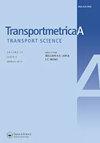Empirical study of the effects of physics-guided machine learning on freeway traffic flow modelling: model comparisons using field data
IF 3.1
2区 工程技术
Q2 TRANSPORTATION
引用次数: 0
Abstract
Recent studies have shown the successful implementation of classical model-based approaches (e.g. macroscopic traffic flow modelling) and data-driven approaches (e.g. machine learning – ML) to model freeway traffic patterns, while both have their limitations. Even though model-based approaches could depict real-world traffic dynamics, they could potentially lead to inaccurate estimations due to traffic fluctuations and uncertainties. In data-driven models, the acquisition of sufficient high-quality data is required to ensure the model performance. However, many transportation applications often suffer from data shortage and noises. To overcome those limitations, this study aims to introduce and evaluate a new model, named as physics-guided machine learning (PGML), that integrates the classical traffic flow model (TFM) with the machine learning technique. This PGML model leverages the output of a traffic flow model along with observational features to generate estimations using a neural network framework. More specifically, it applies physics-guided loss functions in the learning objective of neural networks to ensure that the model not only consists with the training set but also shows lower errors on the known physics of the unlabelled set. To illustrate the effectiveness of the PGML, this study implements empirical studies with a real-world dataset collected from a stretch of I-15 freeway in Utah. Experimental study results show that the proposed PGML model could outperform the other compatible methods, including calibrated traffic flow models, pure machine learning methods, and physics unguided machine learning (PUML).
物理引导机器学习对高速公路交通流建模影响的实证研究:使用现场数据的模型比较
最近的研究表明,经典的基于模型的方法(如宏观交通流建模)和数据驱动的方法(如机器学习- ML)成功地实现了高速公路交通模式的建模,但两者都有其局限性。尽管基于模型的方法可以描述真实世界的交通动态,但由于交通波动和不确定性,它们可能导致不准确的估计。在数据驱动的模型中,需要获取足够的高质量数据来保证模型的性能。然而,许多交通运输应用经常受到数据短缺和噪声的困扰。为了克服这些限制,本研究旨在引入和评估一种新的模型,称为物理引导机器学习(PGML),该模型将经典交通流模型(TFM)与机器学习技术相结合。该PGML模型利用交通流模型的输出以及观测特征,使用神经网络框架生成估计。更具体地说,它在神经网络的学习目标中应用物理引导损失函数,以确保模型不仅与训练集一致,而且在未标记集的已知物理上显示更低的误差。为了说明PGML的有效性,本研究使用从犹他州I-15高速公路一段收集的真实数据集进行了实证研究。实验研究结果表明,PGML模型优于其他兼容方法,包括校准交通流模型、纯机器学习方法和物理非引导机器学习(PUML)。
本文章由计算机程序翻译,如有差异,请以英文原文为准。
求助全文
约1分钟内获得全文
求助全文
来源期刊

Transportmetrica A-Transport Science
TRANSPORTATION SCIENCE & TECHNOLOGY-
CiteScore
8.10
自引率
12.10%
发文量
55
期刊介绍:
Transportmetrica A provides a forum for original discourse in transport science. The international journal''s focus is on the scientific approach to transport research methodology and empirical analysis of moving people and goods. Papers related to all aspects of transportation are welcome. A rigorous peer review that involves editor screening and anonymous refereeing for submitted articles facilitates quality output.
 求助内容:
求助内容: 应助结果提醒方式:
应助结果提醒方式:


